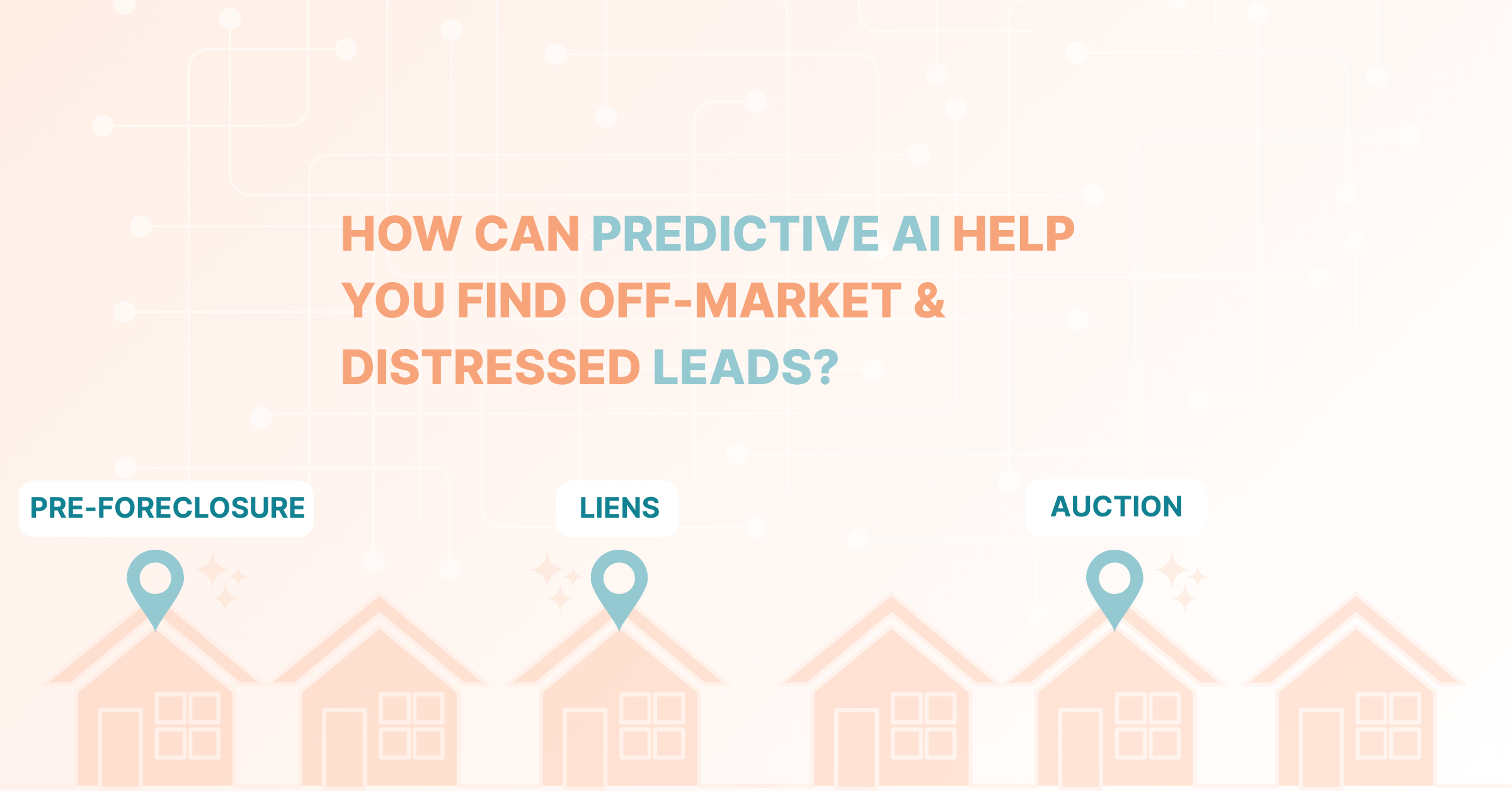With foreclosures increasing across the country throughout 2022, real estate investors may begin to find more deals on properties below market value. But there’s another valuable type of property lead that’s easy to overlook and may offer less competition—pre-foreclosures!
How do you identify and invest in these off-market properties? Let’s take a closer look at pre-foreclosures and what you should know before investing in them.
Table of Contents
- What Are Pre-Foreclosure Properties?
- Why Pre-Foreclosures Make Good Leads
- Is Investing in Pre-Foreclosures Right For You?
- Advantages of Pre-Foreclosures
- Disadvantages of Pre-Foreclosures
- 8 Tips for Investing in Pre-Foreclosures
What Are Pre-Foreclosure Properties?
When a homeowner defaults on their mortgage loan, the lender can foreclose on the home. Pre-foreclosure, the first step in this process, starts when the lender sends a notice of default to the homeowner. This usually happens after the owner has missed three mortgage payments in a row.
If the owner doesn’t pay what they owe, the home will move to foreclosure status, where the lender repossesses the home and sells it at an auction.
Why Pre-Foreclosures Make Good Seller Leads

Pre-foreclosure homes haven’t been auctioned off by the lender yet, which means they’re off-market properties still in possession of the owner. When owners sell a home in pre-foreclosure, they sometimes refer to it as a “short sale” rather than a pre-foreclosure.
Because pre-foreclosures are off the market, they typically get less competition from other buyers. They also tend to sell below market value because the owner wants to get the property off their hands as quickly as possible so they can pay back their lender. Both these factors make pre-foreclosures attractive leads for real estate investors.
Is Investing in Pre-Foreclosure Properties Right for You?
To figure out whether investing in these properties makes sense for your business model, it’s important to weigh the pros and cons of pre-foreclosures.
Advantages of Pre-Foreclosures
As mentioned before, owners facing pre-foreclosure are often motivated to sell their homes quickly. After all, a foreclosure can have a significant impact on their credit and finances. So, they’re often willing to sell their homes for below market rate and close more quickly.
Better access is another benefit of pre-foreclosures. Buyers typically aren’t allowed to inspect properties in foreclosure. But this isn’t the case with pre-foreclosures, which allow you to get a home inspection and appraisal. You may also be able to speak to the homeowner directly to learn more about the home’s history and condition.
Disadvantages of Pre-Foreclosures
Sometimes, pre-foreclosure homes aren’t in great condition. Some homeowners who can’t pay their mortgage may not be able to afford certain maintenance and repair expenses either.
You may also run into unexpected snags during the buying process, such as unpaid taxes or liens.
Lastly, remember that an owner has various opportunities to work something out with their lender during the foreclosure process. During that time, they may come to an agreement to avoid foreclosure and decide not to sell their property after all.
8 Tips for Investing in Pre-Foreclosures
If you decide to invest in pre-foreclosure properties, where should you start? Here are eight helpful ideas to keep in mind when investing in these homes.
1. Find Pre-Foreclosure Opportunities
You won’t find pre-foreclosures on the MLS. Instead, it takes some digging to identify these off-market properties. But with the help of a real estate data tool, this process can be much easier.
For example, with PropStream, you can find pre-foreclosure leads in any region you choose with our convenient Pre-Foreclosure Lead List. You can search by county, city, zip code (up to five zip codes at a time), or address. PropStream’s Draw Tool also allows you to target specific neighborhoods with pre-foreclosures.
Once you’ve found pre-foreclosure leads in the region you’d like to target; you can save those leads to a marketing list. This makes it easier to reach out to them later on.
2. Reach Out to Pre-Foreclosure Leads
With PropStream, you can perform a skip trace to get contact information. Once you have a list of qualified contacts, you can send an email or postcard from within the platform.
Sending emails through PropStream allows you to monitor the click-through rate, while PropStream postcards allow you to use a professionally designed template or a design of your own.
You could also cold-call your pre-foreclosure leads, although this usually takes more time than sending templated emails and postcards. This strategy might work better if you have a shorter list or a few people who can help make phone calls.
3. Run Comps on the Property
Not all pre-foreclosures make great investments.
So, before making an offer, it may be helpful to compare the home to similar properties in the neighborhood. This is called “running comps (comparables)” and can help you find out if the property you’re looking at can yield a profitable return—whether you choose to flip it or rent it out.
4. Negotiate on the Pre-Foreclosed Property

Owners in pre-foreclosure may be more motivated to sell, but that doesn’t mean it’s easy for them to part with their homes. You may find it helpful to keep the owner’s difficult situation in mind when making them an offer and negotiating.
If you want to speed up the buying process, you could consider dropping repair contingencies from the contract. You could also offer to allow the owner to stay in the home for a certain period of time after closing to make their moving process easier.
5. Make a Plan to Finance the Pre-Foreclosed Property
It’s a good idea to have a plan to finance the property before you get too deep into the negotiation process. After all, it may be difficult to get a conventional loan, especially if you own several other investment properties. A few alternative financing options for investors include:
- Hard money loan
- Fix-and-flip loan
- Home equity loan
- Home equity line of credit (HELOC)
- 1031 exchange
Before deciding, you may want to thoroughly research each option to determine which loan terms make the most sense for your business model.
6. Research Property Fees
If you’re planning to hold the home and rent it out, you may want to look into any potential fees related to the property. Here are some common fees investors pay for their rental homes:
- Property taxes
- Utilities
- HOAs
- Maintenance
- Homeowner’s insurance
- Property management fees (if you don’t want to manage the properties yourself)
Before investing in a pre-foreclosure property, make sure the monthly fees don’t eat into your potential profit too much so you can ensure the investment is worthwhile.
7. Get a Home Inspection
Some pre-foreclosure properties need expensive repairs, which can eat into your profit—or even lead to a loss. Many seasoned investors opt for a home inspection before buying a property. An inspection can uncover hidden issues with the home and help you get an idea of how much you’ll need to invest in renovations. You can expect to pay around $300 to $500 for a home inspection, depending on the size, age, and location of the property.
PropStream’s Rehab Calculator makes this process faster by itemizing each repair and offering cost estimates. The more information you provide the calculator, the more accurate your final project estimate will be.
8. Check for Liens
Some pre-foreclosure sellers may tell you upfront about any liens or taxes owed on the property. But unfortunately, this isn’t always the case. If you buy the property without knowing about these debts, you’ll become responsible for paying them.
To avoid taking on another homeowner’s liens, you can do a title search through the county clerk or record office or search directly within the PropStream platform.
Start Finding Pre-Foreclosure Leads Today
Ready to start investing in pre-foreclosure properties?
Start browsing pre-foreclosure leads at no cost today with PropStream’s free 7-day trial! With your 7-day trial, enjoy 50 leads on us.



